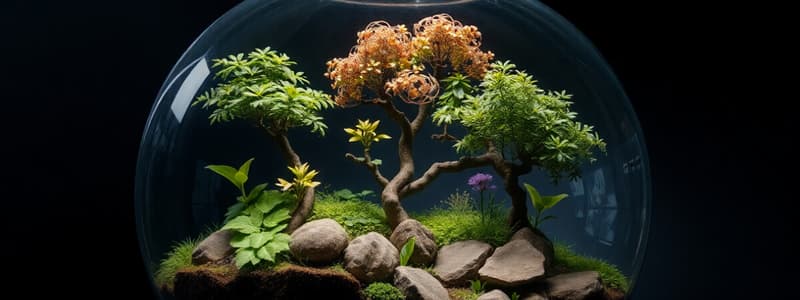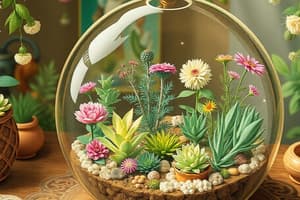Podcast
Questions and Answers
Which layer should be added first when constructing a terrarium?
Which layer should be added first when constructing a terrarium?
- Soil
- Charcoal
- Moss
- Pebbles (correct)
Transpiration occurs when water evaporates from the soil.
Transpiration occurs when water evaporates from the soil.
False (B)
What should be inspected before placing plants in the terrarium?
What should be inspected before placing plants in the terrarium?
disease
In the water cycle, __________ occurs when water vapour in the air cools to form liquid water.
In the water cycle, __________ occurs when water vapour in the air cools to form liquid water.
Match the following components of the water cycle with their descriptions:
Match the following components of the water cycle with their descriptions:
How many grams of charcoal should be added for the second layer in the terrarium?
How many grams of charcoal should be added for the second layer in the terrarium?
Worms should not be added to the terrarium because they can harm the plants.
Worms should not be added to the terrarium because they can harm the plants.
Name one process that moves carbon between stores in a terrarium.
Name one process that moves carbon between stores in a terrarium.
Excess moisture in a terrarium can lead to the growth of __________.
Excess moisture in a terrarium can lead to the growth of __________.
What is the ideal condition for the plants in a terrarium?
What is the ideal condition for the plants in a terrarium?
What is the main benefit of adding charcoal to a terrarium?
What is the main benefit of adding charcoal to a terrarium?
A terrarium can only exist in an open system.
A terrarium can only exist in an open system.
What role do pebbles play in a terrarium?
What role do pebbles play in a terrarium?
The __________ layer helps keep the soil moist without making it overly wet.
The __________ layer helps keep the soil moist without making it overly wet.
Match the components of a terrarium with their functions:
Match the components of a terrarium with their functions:
Which component helps combat mould in a terrarium?
Which component helps combat mould in a terrarium?
The soil in a terrarium has no necessary nutrients for plant health.
The soil in a terrarium has no necessary nutrients for plant health.
What is the purpose of having a layer of sphagnum moss in a terrarium?
What is the purpose of having a layer of sphagnum moss in a terrarium?
The terrarium ecosystem relies on __________ cycling and gas exchange to sustain life.
The terrarium ecosystem relies on __________ cycling and gas exchange to sustain life.
Which of the following is a primary abiotic component of a terrarium?
Which of the following is a primary abiotic component of a terrarium?
What is the main purpose of adding pebbles in a terrarium?
What is the main purpose of adding pebbles in a terrarium?
Worms in a terrarium help to aerate the soil and break down decaying matter.
Worms in a terrarium help to aerate the soil and break down decaying matter.
What component serves to remove toxins in a terrarium?
What component serves to remove toxins in a terrarium?
The __________ helps to keep the soil moist without making it overly wet.
The __________ helps to keep the soil moist without making it overly wet.
Match the following terrarium components with their functions:
Match the following terrarium components with their functions:
Why is the terrarium considered a self-sustaining closed system?
Why is the terrarium considered a self-sustaining closed system?
Sphagnum moss should be placed under the soil layer in a terrarium.
Sphagnum moss should be placed under the soil layer in a terrarium.
Name one organism that helps control the growth of mould in a terrarium.
Name one organism that helps control the growth of mould in a terrarium.
Soil in a terrarium contains __________ that are necessary for plant health.
Soil in a terrarium contains __________ that are necessary for plant health.
Which element is NOT a biotic component of a terrarium?
Which element is NOT a biotic component of a terrarium?
What is the main function of the charcoal layer in a terrarium?
What is the main function of the charcoal layer in a terrarium?
Water infiltration occurs when water vapour in the air cools to form liquid water.
Water infiltration occurs when water vapour in the air cools to form liquid water.
What are the three primary components that should be layered in a terrarium below the plants?
What are the three primary components that should be layered in a terrarium below the plants?
One of the processes that contribute to the carbon cycle in a terrarium is __________.
One of the processes that contribute to the carbon cycle in a terrarium is __________.
Match the following processes with their descriptions in the water cycle:
Match the following processes with their descriptions in the water cycle:
What is the purpose of spritzing water in the terrarium?
What is the purpose of spritzing water in the terrarium?
The plants should be fast-growing and require a lot of sunlight to thrive in a terrarium.
The plants should be fast-growing and require a lot of sunlight to thrive in a terrarium.
Name one animal that can be added to a terrarium to aid in the ecosystem.
Name one animal that can be added to a terrarium to aid in the ecosystem.
The __________ cycle involves processes such as evaporation and precipitation within the terrarium.
The __________ cycle involves processes such as evaporation and precipitation within the terrarium.
How many grams of pebbles should be added for the first layer in the terrarium?
How many grams of pebbles should be added for the first layer in the terrarium?
Flashcards
Terrarium Components
Terrarium Components
A terrarium is a closed ecosystem with living and non-living parts (biotic and abiotic components) working together to support each other.
Pebbles Function
Pebbles Function
Pebbles act as a drainage layer, preventing water from pooling around plant roots, which stops rot and mold growth.
Charcoal Role
Charcoal Role
Charcoal absorbs harmful chemicals in the soil, water, and air, preventing buildup and promoting a healthier environment.
Moss Function
Moss Function
Signup and view all the flashcards
Soil Role
Soil Role
Signup and view all the flashcards
Worms' Importance
Worms' Importance
Signup and view all the flashcards
Terrarium Drainage
Terrarium Drainage
Signup and view all the flashcards
Self-Sustaining System
Self-Sustaining System
Signup and view all the flashcards
Material Order
Material Order
Signup and view all the flashcards
Terrarium Size Layer
Terrarium Size Layer
Signup and view all the flashcards
Terrarium Plants
Terrarium Plants
Signup and view all the flashcards
Terrarium Water
Terrarium Water
Signup and view all the flashcards
Terrarium Layers
Terrarium Layers
Signup and view all the flashcards
Terrarium Construction Method
Terrarium Construction Method
Signup and view all the flashcards
Water Cycle (Terrarium)
Water Cycle (Terrarium)
Signup and view all the flashcards
Evaporation (Terrarium)
Evaporation (Terrarium)
Signup and view all the flashcards
Transpiration (Terrarium)
Transpiration (Terrarium)
Signup and view all the flashcards
Carbon Cycle (Terrarium)
Carbon Cycle (Terrarium)
Signup and view all the flashcards
Photosynthesis
Photosynthesis
Signup and view all the flashcards
Respiration
Respiration
Signup and view all the flashcards
Terrarium Drainage Layer
Terrarium Drainage Layer
Signup and view all the flashcards
Charcoal's Role
Charcoal's Role
Signup and view all the flashcards
Moss's Function
Moss's Function
Signup and view all the flashcards
Soil's Role
Soil's Role
Signup and view all the flashcards
Worms Role
Worms Role
Signup and view all the flashcards
Terrarium Materials Order
Terrarium Materials Order
Signup and view all the flashcards
Layer Importance
Layer Importance
Signup and view all the flashcards
Self-sustaining Ecosystem
Self-sustaining Ecosystem
Signup and view all the flashcards
Terrarium Benefits - Worms
Terrarium Benefits - Worms
Signup and view all the flashcards
Terrarium Nutrient Cycle
Terrarium Nutrient Cycle
Signup and view all the flashcards
Terrarium Plants
Terrarium Plants
Signup and view all the flashcards
Terrarium Watering
Terrarium Watering
Signup and view all the flashcards
Terrarium Layers
Terrarium Layers
Signup and view all the flashcards
Evaporation (Terrarium)
Evaporation (Terrarium)
Signup and view all the flashcards
Transpiration (Terrarium)
Transpiration (Terrarium)
Signup and view all the flashcards
Carbon Cycle (Store)
Carbon Cycle (Store)
Signup and view all the flashcards
Carbon Cycle (Feeding)
Carbon Cycle (Feeding)
Signup and view all the flashcards
Carbon Cycle (Photosynthesis)
Carbon Cycle (Photosynthesis)
Signup and view all the flashcards
Water Cycle (Condensation)
Water Cycle (Condensation)
Signup and view all the flashcards
Terrarium Construction
Terrarium Construction
Signup and view all the flashcards
Study Notes
Terrarium Objectives
- Students will work collaboratively to create a terrarium
- Students will understand terrarium components and their functions
- Students will understand the chemical reactions in a terrarium
- Students will grasp that terrariums are self-sustaining closed systems
Terrarium Components
- A terrarium is a self-sustaining ecosystem. It has both biotic and abiotic factors
- Even though it is closed, biotic factors can survive due to nutrient cycling and gas exchange
Materials List
- Dried moss, worms, plants, pebbles, soil, charcoal
- Two large glass salad bowls and water
Terrarium Design Planning
- What order should the materials be added? Explain your reasoning
- Does the size of each layer matter? Justify your answer
- What are the functions of each component?
Pebbles
- Pebbles are for drainage to prevent water accumulation around plant roots, which can lead to mold and root rot
Charcoal
- Charcoal's main benefit is toxin removal
- It absorbs chemicals from soil, water, and air that might build up overtime
- A layer of charcoal also creates drainage to prevent excess water from staying in the soil, leading to root rot and mold
Dried Sphagnum Moss
- Dried sphagnum moss increases the soil's capacity to hold water and nutrients
- It helps maintain a consistent level of soil moisture, without being overly wet
- A moss layer on top of pebbles prevents soil from mixing with the pebbles
Soil
- Soil gives structure for plant roots to grow
- It holds water for the plants
- It contains nutrients like nitrogen that plants need to be healthy
- Soil contains decomposers (bacteria and fungi) that recycle nutrients
Worms
- Worms are detritivores
- They help break down decaying matter and aerate the soil
- Springtails can combat the common terrarium problem of mold, feeding off mold and dead vegetation
- Millipedes, another beneficial organism, are scavengers that eat decaying wood, leaves, and other undesirable matter
Plants
- Plants should be slow-growing and tolerant of humid conditions.
- Inspect plants for disease before adding to the terrarium
Water
- Spritz soil and leaves with water
- Be careful not to overwater the terrarium, as excess moisture may cause mold growth
Terrarium Layers
- The order to layer a terrarium is: pebbles, charcoal, moss, soil, and plants
Terrarium Method
- Steps on how to assemble a terrarium, including quantities, and sizes for each component, such as soil, moss and pebbled.
Water Cycle
- Discuss the water cycle in the terrarium, including evaporation, transpiration, condensation, and precipitation.
Carbon Cycle
- Explain the carbon cycle within the terrarium, considering the roles of animals, plants, and carbon dioxide. Discuss processes such as feeding, respiration, and photosynthesis.
Studying That Suits You
Use AI to generate personalized quizzes and flashcards to suit your learning preferences.
Related Documents
Description
This quiz focuses on the process of creating a terrarium, emphasizing teamwork and understanding of its components. Students will explore the functions of each part, the critical chemical reactions involved, and the concept of self-sustaining ecosystems. Engage with practical design planning and reasoning for building your terrarium.




